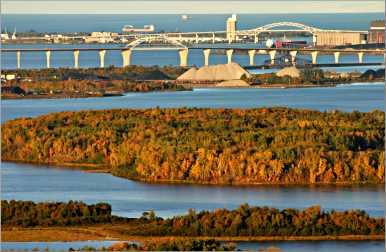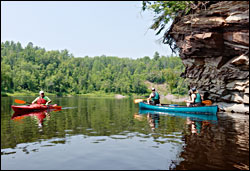On the water in West Duluth
On the once-gritty St. Louis River, boaters and birders enjoy the scenery.

© Beth Gauper
In Duluth, there's water — a lot of water — beyond the big lake and the Aerial Lift Bridge.
The St. Louis River is the largest U.S. tributary to Lake Superior, and it creates a huge estuary as it approaches the lake.
Fishermen and bird-watchers have frequented it for years, and more are showing up as the water becomes cleaner. Sturgeon have come back, eagles nest, and 70 percent of the birds seen in Minnesota come through on fall and spring migrations.
The St. Louis also is a state water trail, and paddlers like to explore the many peninsulas and islands. They can even hitch a ride on the Lake Superior & Mississippi Railroad and return by canoe or kayak.
The busiest spot on the river is Boy Scout Landing, where there's a popular fishing pier as well as boat launch. That's where we put in one sunny day in July, briefly piloting ourselves into a bay before finding the correct route, roughly along the Minnesota-Wisconsin border.
The Ojibwe paddled here first, followed by fur traders and missionaries. After rail lines were built, U.S. Steel moved in, from 1913 to 1981 operating a plant that left the water thoroughly polluted.
Governmental units still are working to stabilize sediment. But on the surface, all anyone can see are islands, trees and the occasional fish jumping from clear water.
There are a few houses, too, and we wondered what it would be like to live so close to the river and its abundant fish and birds.
At Fond du Lac Campground, we stopped to eat our bag lunches on a dock. Then we passed under the Highway 23 bridge and by Fond du Lac city park, near the site where John Jacob Astor built a fur post that lasted until 1847.
From there, it was just our two kayaks, our canoe and an eagle that flew lazily overhead.

© Beth Gauper
Crumbling cliffs began to rise along the river, topped with bushes and trees, and we spied the remains of a stone abutment that once supported financier Jay Cooke's railroad, which ran through the state park now named for him.
As the river narrowed, pink cliffs rose straight from the water, and we pulled up to admire the artfully blocky patterns of rock jutting from the surface, punctuated by clumps of drooping harebells.
When we saw the Fond du Lac Dam, we knew we were at the end of the line. But we weren't ready to go home, so we pulled our boats onto a cobblestone beach, found a quiet eddy in the lee of a giant boulder and went for a swim.
Finally, we turned around and began the five-mile paddle back.
Trip Tips: Paddling in West Duluth
Getting there: Take the Grand Avenue exit from I-35. Grand Avenue turns into Minnesota 23, or Commonwealth Avenue.
Annual events: August, St. Louis River Alliance Community Canoe/Kayak Tour and Picnic.
The Lake Superior & Mississippi Railroad offers excursions at 10:30 a.m. and 1:30 p.m. Saturdays and Sundays from mid-June to mid-October. Board the train at Spirit Lake Marina, pick up a kayak or canoe at Boy Scout Landing and paddle back to the marina, about five miles.
Cost is $20 for the train ride and $35-$45 for a canoe or kayak. Passengers also can use their own boats.
Paddling: The Lower St. Louis River is a state water trail. The 10 miles between Canal Park and Indian Point Campground are part of shipping lanes, so paddlers have to be careful.
From Indian Point, it's 11 miles to the Fond du Lac Dam. The five-mile stretch from Boy Scout Landing to the dam makes a nice half-day trip.
Rentals: Spirit Lake Marina rents canoes, kayaks and pontoons just north of the Clyde Avenue landing, across from Clough Island, 218-628-3578.
Fond du Lac Campground, adjacent to Chambers Grove City Park, rents canoes and kayaks.

© Beth Gauper
Boat launches: There are landings at Clyde Avenue, off Grand Avenue, and at Boy Scout Landing, farther along the river off Minnesota 23.
There's also canoe and kayak access at Chambers Grove Park in Fond du Lac, at the junction of Minnesota 23 and 210.
Fishing: The St. Louis River estuary includes walleye, sturgeon, catfish, pike, rock bass and muskies. Boy Scout Landing has a popular fishing pier.
Whitewater rafting: Swiftwater Adventures offers two-hour raft trips on the St. Louis above the Thomson Dam.
Camping: There's camping along the river at the municipal Indian Point Campground, Spirit Lake Marina, River Place Campground, next to Boy Scout Landing, and Fond du Lac Campground, next to Chambers Grove Park.
Information: Pick up the free, 66-page On-The-Water Guide for Paddlers & Boaters at city offices and businesses around town, including Spirit Lake Marina and the Munger Inn.
West Duluth also is a hiking and biking destination, with trailheads for the Waabizheshikana, formerly the Western Waterfront Trail, and the Willard Munger State Trail.
For more, see Duluth's other waterfront.